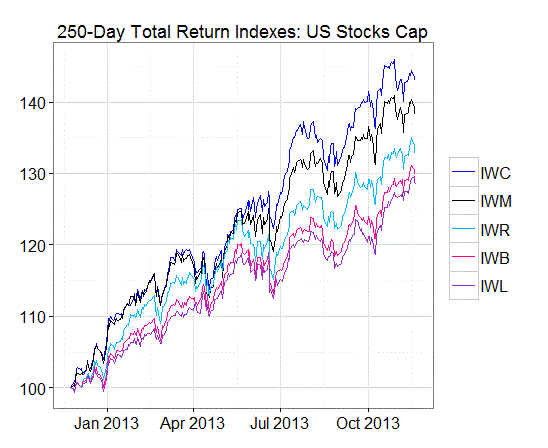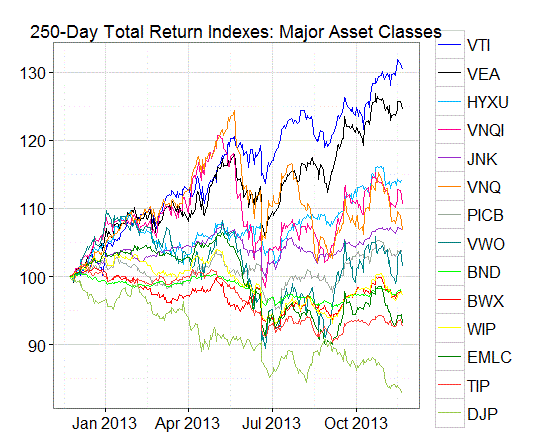Paul Merriman concludes that “rebalancing could be a huge mistake.” Perhaps, although it could also turn out to be a huge benefit. Then again, it’s more likely that rebalancing’s effects will fall somewhere between those two extremes for most portfolios. In any case, Merriman’s focus is sensible, even if his conclusion is extreme. You just can’t spend too much time thinking about rebalancing. Even if you decide to shun it completely, which Merriman comes close to advocating for equity strategies, your rebalancing choices are likely to be critical factors for driving portfolio results through time.
The glitch, of course, is that the optimal rebalancing strategy is unknown in real time. We know what would have worked had you applied it rigorously in the past. But it’s never really clear how the rear-view mirror will inform our analysis going forward. In my book Dynamic Asset Allocation, I reviewed a number of rebalancing studies and found that there’s a conspicuous lack of consensus about what works and what doesn’t. The list of research reports on this topic continues to grow, but there’s still no clear rule other than you probably should rebalance in some degree. Otherwise, the ongoing debate on the details isn’t surprising since rebalancing’s results are highly dependent on several variables, including:
• The choice of asset classes
• The investment time horizon
• The rebalancing frequency
If you’re kicking the tires on an equities-only portfolio, the expected results with rebalancing looks substantially different vs. the same analysis for a multi-asset-class strategy. Again, this isn’t terribly surprising and for reasons that should be obvious. No matter how finely you slice up a given asset class, there’s always going to be a relatively high degree of correlation across the parts. In turn, that casts a long shadow on how rebalancing will play out with the portfolio. Meanwhile, correlations across asset classes are going to be considerably lower, which also has implications for rebalancing.
As an example, let’s review performance for US equities from three perspectives and then compare the results with the major asset classes. First, consider the US stock market based on dividing companies into five categories of market capitalization. Although there’s a fair amount of variation in the performance results, the fluctuations across market caps are highly correlated. (The following charts use ETF proxies with daily prices rebased to 100 for the start date that covers the 250 trading days through yesterday, November 20.)

US Mega Cap Stocks (IWL)
US Large Cap Stocks (IWB)
US Mid Cap Stocks (IWR)
US Small Cap Stocks (IWM)
US Micro Cap Stocks (IWC)
It’s the same story when we look at US stocks via style (value vs. growth) across the various market-cap buckets:

US Large Cap Growth Stocks (IWF)
US Large Cap Value Stocks (IWD)
US Mid Cap Growth Stocks (IWP)
US Mid Cap Value Stocks (IWS)
US Small Cap Growth Stocks (IWO)
US Small Cap Value Stocks (IWN)
There’s more divergence when we slice up US equities by sectors, but it’s clear that the broad equity market beta remains a strong influence.

US Consumer Discretionary (XLY)
US Consumer Staples (XLP)
US Energy (XLE)
US Financials (XLF)
US Healthcare (XLV)
US Industrials (XLI)
US Materials (XLB)
US Technology (XLK)
US Utilities (XLU)
Finally, consider how the major asset classes compare, as shown in the next chart below. Note the wide spectrum of performance results. No one will confuse this history with the profile for US equities. The implication: rebalancing will probably be more productive in the multi-asset class portfolio vs. a US equities portfolio.

US Stocks (VTI)
Foreign Stocks Devlp’d Mkts (VEA)
Emg Mkt Stocks (VWO)
US REITs (VNQ)
US Bonds (BND)
US TIPS (TIP)
US Junk Bonds (JNK)
Foreign Devlp’d Mkt Gov’t Bonds (BWX)
Emg Mkt Gov’t Bonds (EMLC)
Commodities (DJP)
Foreign Gov’t Inflation-Linked Bonds (WIP)
Foreign Invest-Grade Corp Bonds (PICB)
Foreign Junk Bonds (HYXU)
Foreign REITs (VNQI)
The key message is that a rebalancing strategy should be customized to match the particulars of a given portfolio. In some cases, no rebalancing may be the preferred choice. As always, much depends on the underlying choice of assets, the investment time horizon, the investor’s risk tolerance, and so on. But no matter what you decide, rebalancing will be a crucial factor one way or another. The only mistake is thinking otherwise.